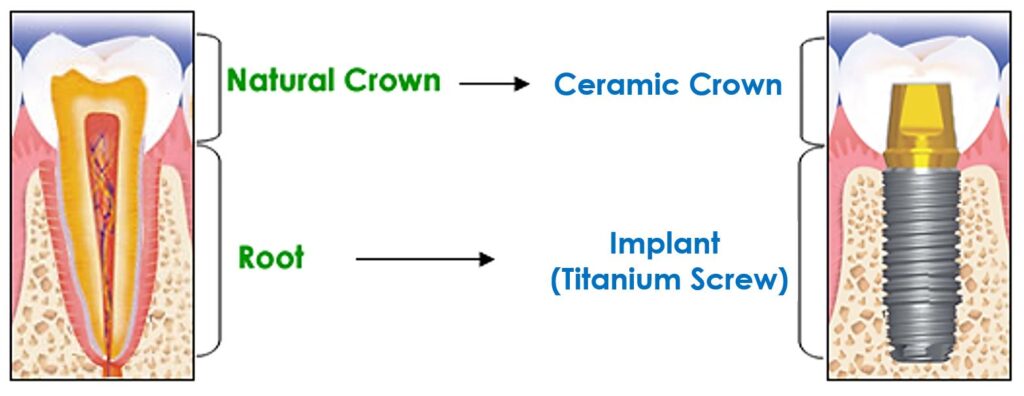Dental Implants – the closest thing to natural teeth
Understanding a Dental Implant
- The part above the gum is called the crown. This is the white portion that you see in the mouth.
- The part below the gum is the root. This is the portion that keeps your tooth firm because it is held by your jaw bone.
Just like a natural tooth, an implant is held by your jawbone so your new artificial tooth feels secure and you can enjoy confidence when you eat, speak or smile!

To replace a single lost tooth, an implant, or a titanium screw, is inserted into the bone. In the typical case, the implant would be covered by gum and left for 2-4 months. This allows the bone to heal around the implant and hold it firmly. This process of healing and bonding with the bone is called osseo-integration.
After the bone has healed well around the implant, a small extension, or abutment (post), would be placed over the implant. A new customized crown would be constructed and cemented over the abutment. You will then have a brand new tooth!
In some cases, a temporary plastic crown can be placed over a newly placed implant. Whether this can be done depends on factors like whether there is a critical need for an immediate aesthetic replacement, whether biting forces will be placed on the tooth, the quantity and quality of bone supporting the implant.
What are the limitations to implant placement?
- There must be bone of sufficient height and width to support the implant. In cases of inadequate bone, a graft may be required to give stability to the implant.
- The patient must be in good health, for example, conditions like diabetes must be well-controlled.
- Any infection, like a gum abscess, must be resolved first, before the implant is placed.
- Smokers will find that healing around the implant may be compromised.
- Those who brux their teeth (i.e. grind their teeth excessively) may find that the longevity of their implants will be undermined. To help manage this, a plastic guard may need to be worn to protect the implant as well as the natural teeth.
What are the stages in getting Dental Implants?
The initial consultation
Firstly, your condition must be examined to assess whether you are suitable for implants. For example, do you have any medical conditions that may affect the success of an implant? Then your mouth has to be checked for bone shape, size and quality. In some cases, bone grafts may be needed if the proposed site of the implant has very thin bone. Only after a thorough examination that includes X-rays, can we plan how your new artificial teeth will be constructed.
X-ray examination often includes 3-D imaging (a special kind of computerized imaging called CBCT) to determine the three-dimensional volume of bone at the site and to assess proximity to certain anatomical structures,
The Implant Insertion
The implant will be placed into the site of your missing tooth and allowed to heal for a few months.
The Artificial Teeth
In the case of single tooth replacement, a crown would be placed on top of the implant after the implant has completely healed in the mouth.
In cases where multiple teeth are being replaced, the design may involve a bridge supported on implants, a denture fixed to implants or a removable denture retained by a few implants.
Will there be pain?
In the typical case, insertion of the implant is done under local anaesthetic i.e. the site of the missing tooth will be made numb for a few hours. After the anaesthetic wears out, painkillers will manage any pain. In many cases, patients only report some soreness for a few days.
In situations where grafts are involved i.e. in areas where there is little bone left at the site of the missing tooth, there will be some swelling for a few days. This is a natural reaction of the body and resolves within a few days. Again, medication will be given to help healing and reduce discomfort.
What are the fees?
The fee for dental implants vary considerably depending on whether a graft is needed, the design & materials used for the crown or bridge. The designs and fees will be discussed on an individual basis.
Can Medisave be used?
Yes
Medisave can be used to pay for part of the fee for the surgical insertion of the implant.
What are the risks of Dental Implants?
Please watch this video
